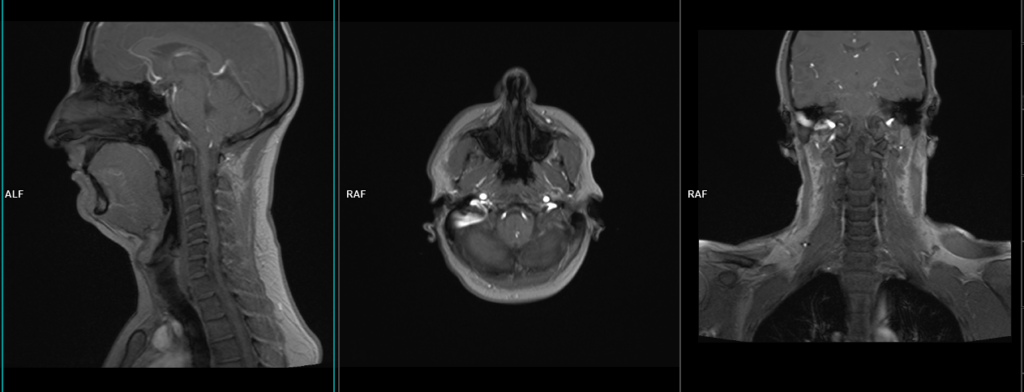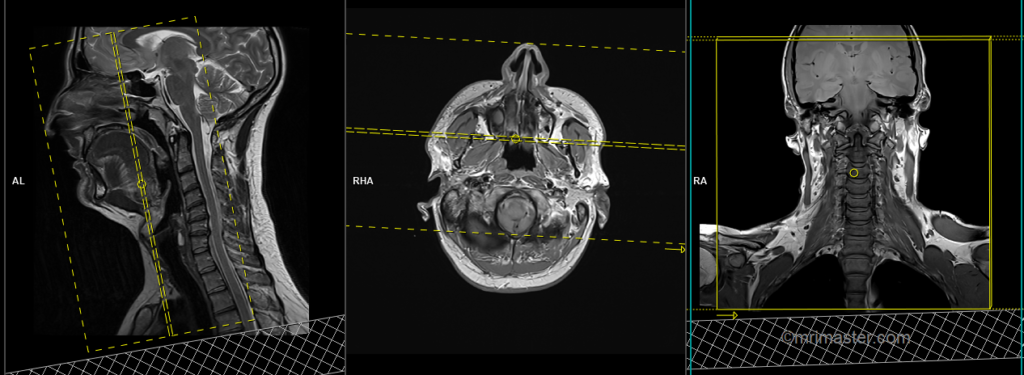Soft Tissue Neck MRI
Indications for soft tissue neck MRI scan
- Abnormalities noted on other imaging or endoscopic studies
- Staging of known malignancy of head and neck
- Congenital anomalies (e.g., branchial cleft cyst)
- Treatment planning for radiation therapy
- Evaluation of response to treatment
- Pre-operative evaluation of tumours
- Presence of a foreign body
- Upper airway obstruction
- Obstructive thyroid disease
- Head/neck abscess
- Retropharyngeal abscess
- Tracheal stenosis
- Vocal cord paralysis
- Tracheal stenosis
- Lymphadenopathy
- Nasopharynx tumours
- Parotid tumor
- Orbital tumours
- Trauma
Contraindications
- Any electrically, magnetically or mechanically activated implant (e.g. cardiac pacemaker, insulin pump biostimulator, neurostimulator, cochlear implant, and hearing aids)
- Intracranial aneurysm clips (unless made of titanium)
- Pregnancy (risk vs benefit ratio to be assessed)
- Ferromagnetic surgical clips or staples
- Metallic foreign body in the eye
- Metal shrapnel or bullet
Patient preparation for soft tissue neck MRI scan
- A satisfactory written consent form must be taken from the patient before entering the scanner room
- Ask the patient to remove all metal objects including keys, coins, wallet, cards with magnetic strips, jewellery, hearing aid and hairpins
- Ask the patient to undress and change into a hospital gown
- Contrast injection risk and benefits must be explained to the patient before the scan
- Gadolinium should only be given to the patient if GFR is > 30
- If possible provide a chaperone for claustrophobic patients (e.g. relative or staff )
- Offer earplugs or headphones, possibly with music for extra comfort
- Explain the procedure to the patient
- Instruct the patient to keep still
- Note the weight of the patient
Positioning for soft tissue neck MRI
- Head first supine
- Position the head in the head and neck coil and immobilise with cushions
- Give cushions under the legs for extra comfort
- Centre the laser beam localiser over the mid neck (1 inch below the chin in chin down position)

Recommended Soft Tissue Neck MRI Protocols and Planning
Soft tissue neck MRI localiser
A three-plane localizer must be taken at the beginning to localize and plan the sequences. Localizers are normally less than 25 seconds and are T1-weighted low-resolution scans.

T2 stir coronal 3mm 280FOV
Plan the coronal slices on the sagittal plane, and angle the planning block parallel to the cervical spine. Check the planning block in the other two planes. An appropriate angle must be given in the axial plane (perpendicular to the nasal septum). The slices must be sufficient to cover the soft tissue of the neck from the nose tip up to the line of the spinous process of the cervical spine. The field of view (FOV) must be large enough to cover the entire neck from the frontal sinus down to the clavicle. The phase direction in the coronal scans must be from right to left; this is to avoid artifacts from chest and heart motion.
During the sequence acquisition, it is crucial to instruct the patient not to swallow. In our imaging department, we provide 30 seconds after each scan for the patient to swallow saliva. This precaution helps prevent motion artifacts in the neck during image acquisition. Additionally, the use of saturation bands under the coronal block can effectively reduce arterial pulsation artifacts.

Parameters
TR 5000-6000 | TE 110 | FLIP 150 | NEX 2 | SLICE 3 MM | MATRIX 384X320 | FOV 280-300 | PHASE R>L | GAP 10% | TI 150 |
T1 tse coronal 3mm 280FOV
Plan the coronal slices on the sagittal plane, and angle the planning block parallel to the cervical spine. Check the planning block in the other two planes. An appropriate angle must be given in the axial plane (perpendicular to the nasal septum). The slices must be sufficient to cover the soft tissue of the neck from the nose tip up to the line of the spinous process of the cervical spine. The field of view (FOV) must be large enough to cover the entire neck from the frontal sinus down to the clavicle. The phase direction in the coronal scans must be from right to left; this is to avoid artifacts from chest and heart motion.
During the sequence acquisition, it is crucial to instruct the patient not to swallow. In our imaging department, we provide 30 seconds after each scan for the patient to swallow saliva. This precaution helps prevent motion artifacts in the neck during image acquisition. Additionally, the use of saturation bands under the coronal block can effectively reduce arterial pulsation artifacts.

Parameters
TR 500-700 | TE 15-25 | SLICE 3 MM | FLIP 140 | PHASE R>L | MATRIX 384X384 | FOV 280-300 | GAP 10% | NEX(AVRAGE) 2 |
T1 tse axial 3mm 270 FOV
Plan the axial slices on the sagittal plane: angle the planning block horizontally across the neck (approximately parallel to the hard palate in a chin-down position). Check the planning block in the other two planes. An appropriate angle must be given in the coronal plane (perpendicular to the cervical spine). Slices must be sufficient to cover the soft tissue of the neck from the frontal sinus down to the line of the sterno-clavicular joint. The phase direction in the axial scans must be right to left with 100% oversample. This will reduce wrap around, arterial pulsation and swallowing artifacts.
It is important to instruct the patient to avoid swallowing during the sequence acquisition (in our imaging department, we give 30 seconds after each scan for the patient to swallow saliva). This will prevent motion artifacts in the neck during image acquisition. Using saturation bands under the axial block can further reduce arterial pulsation artifacts.

Parameters
TR 500-650 | TE 15-25 | SLICE 3 MM | FLIP 140 | PHASE R>L | MATRIX 384X384 | FOV 270-290 | GAP 10% | NEX(AVRAGE) 2 |
T2 STIR axial 4mm 270 FOV
Plan the axial slices on the sagittal plane: angle the planning block horizontally across the neck (approximately parallel to the hard palate in a chin-down position). Check the planning block in the other two planes. An appropriate angle must be given in the coronal plane (perpendicular to the cervical spine). Slices must be sufficient to cover the soft tissue of the neck from the frontal sinus down to the line of the sterno-clavicular joint. The phase direction in the axial scans must be right to left with 100% oversample. This will reduce wrap around, arterial pulsation and swallowing artifacts.
It is important to instruct the patient to avoid swallowing during the sequence acquisition (in our imaging department, we give 30 seconds after each scan for the patient to swallow saliva). This will prevent motion artifacts in the neck during image acquisition. Using saturation bands under the axial block can further reduce arterial pulsation artifacts.

Parameters
TR 6000-7000 | TE 110 | FLIP 150 | NEX 2 | SLICE 3 MM | MATRIX 320X320 | FOV 270-290 | PHASE R>L | GAP 10% | TI 150 |
DWI epi2scan trace axial 4mm
Plan the axial slices on the sagittal plane: angle the planning block horizontally across the neck (approximately parallel to the hard palate in a chin-down position). Check the planning block in the other two planes. An appropriate angle must be given in the coronal plane (perpendicular to the cervical spine). Slices must be sufficient to cover the soft tissue of the neck from the frontal sinus down to the line of the sterno-clavicular joint.
Phase direction in the axial scans must be anterior to posterior with the smallest possible phase FOV (i.e., the upper border touching the nose and the lower border touching the spinous process). This is to reduce air-skin interface artifacts in the neck area.
It is important to instruct the patient to avoid swallowing during the sequence acquisition (in our imaging department, we give 30 seconds after each scan for the patient to swallow saliva). This will avoid motion artifacts in the neck during image acquisition.

Parameters
TR 5000-6000 | TE 110 | FLIP 130 | NEX 7 | SLICE 5 MM | MATRIX 192X192 | FOV 210-230 | PHASE R>L | GAP 10% | B VALUE 0 800 |
T2 tse sagittal 4mm 280 -300 FOV
Plan the sagittal slices on the coronal plane: angle the planning block parallel to the cervical spine. Check the planning block in the other two planes. An appropriate angle must be given in the axial plane (parallel to the nasal septum). Slices must be sufficient to cover the soft tissue of the neck from the right ear (RT pinna) to the left ear (LT pinna). The field of view (FOV) must be large enough to cover the entire neck from the frontal sinus down to the clavicle.
Phase direction in the sagittal scans must be anterior to posterior with 100% oversample. Giving 100% oversample will help to shift the arterial pulsation and swallowing artifacts away from the area of interest.
It’s very important to instruct the patient to avoid swallowing during the sequence acquisition (in our imaging department, we give 30 seconds after each scan for the patient to swallow saliva). This will prevent motion artifacts in the neck during image acquisition. Using saturation bands under the sagittal block can reduce arterial pulsation artifacts.

Parameters
TR 4000-5000 | TE 110 | FLIP 130 | NEX 2 | SLICE 3 MM | MATRIX 384X384 | FOV 290-300 | PHASE A>P | GAP 10% | OVERSAMPLE 100% |
T1 VIBE DIXON\SPACE FAT SAT axial .9mm ISOTROPIC
Plan the axial 3D block on the sagittal plane: angle the position horizontally across the neck (approximately parallel to the hard palate in a chin-down position). Check the positioning block in the other two planes. An appropriate angle must be given in the coronal plane (perpendicular to the cervical spine). Slices must be sufficient to cover the soft tissue of the neck from the frontal sinus down to the line of the sterno-clavicular joint.The phase direction in the axial 3D scans can be anterior to posterior with minimal oversampling. This is because the 3D VIBE sequences are less sensitive to flow-related artifacts.
It is important to instruct the patient to avoid swallowing during the sequence acquisition (in our imaging department, we give 30 seconds after each scan for the patient to swallow saliva). This will prevent motion artifacts in the neck during image acquisition.

Parameters
TR 6-7 | TE 2.39 4.77 | SLICE .9 MM | FLIP 12 | PHASE A>P | MATRIX 288X288 | FOV 270-290 | GAP 10% | NEX(AVRAGE) 2 |


